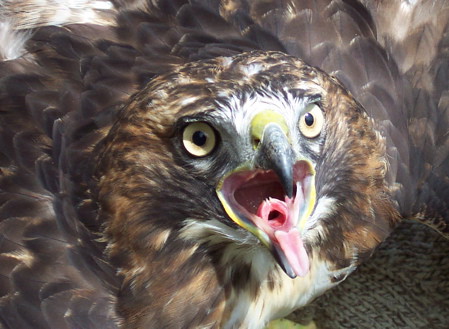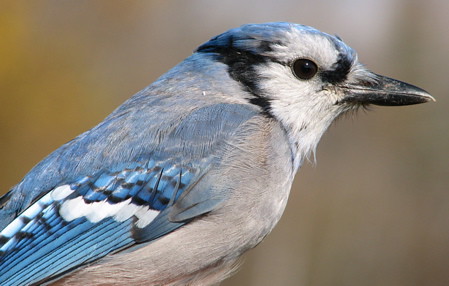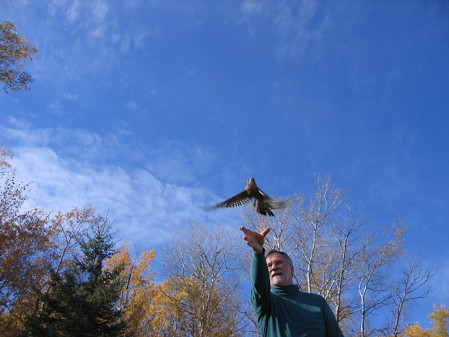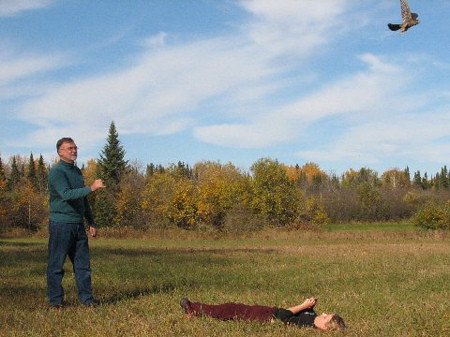I'm always amazed at how closely people pay attention to the blog. When I wrote earlier that I was on a tight budget and didn't know if I could go up hawk banding this fall, invitations came from all over for free housing. I am sometimes overwhelmed by friends and their generosity. Another example is what I say I'm going to blog about. While I was having a great time at the banding station, one of the sub banders named Rick said, "Aren't you going to take pictures of the setup?"
"Huh?" I asked.
"You said that you were going to explain how we band the hawks up here." he reminded me. And he was right, I do need to explain the set up so this post will explain that. One BIG point to stress about banding birds:
Because banding birds requires capturing the birds and handling them before the banding takes place, the banding of birds in the United States is controlled under the Migratory Bird Treaty Act and requires a federal banding permit. Some states require a state permit as well. Only official federal bands may be legally placed on birds that are released to the wild within the United States.
You can read more about banding birds at the Bird Banding Lab. I'm fortunate enough to know several researchers who band different types of birds (pelicans, hawks, songbirds, herons) and allow me to tag along and carry equipment and now I'm to the point where I'm actually learning to do different aspects of it. This is just how this particular banding station works and records data, every station is different. This station in Duluth, MN is run by Frank Taylor, who has been banding hawks longer than even Hawk Ridge--38 years--and he doesn't look a day over 39.
 Here are the nets. Can you see them? There are two different ones there, right in front of the trees--can't you see them? Heck, I took the photo and I can't even see them. Let's look at them from a different angle:
Here are the nets. Can you see them? There are two different ones there, right in front of the trees--can't you see them? Heck, I took the photo and I can't even see them. Let's look at them from a different angle:
 These are the front nets and this photo was taken from the banding blind where we hide while the hawks fly in. The nets form a sort of U-shape, with the open end of the U facing the blind. There are nets surrounding the bait bird (pigeon). Most hawks aim for the pigeon and fly into the front net, but some species are able to see the front net at the last second, dodge above it and as they go up and over, end up in the nets behind the pigeon. Sometimes, they hawks are so fast and maneuver so quick, they elude both front and back nets! It's incredible to watch the mad flight skills of all raptor species. Even a big chunky buteo like a red-tailed hawk has some fast peregrine moves inside it.
These are the front nets and this photo was taken from the banding blind where we hide while the hawks fly in. The nets form a sort of U-shape, with the open end of the U facing the blind. There are nets surrounding the bait bird (pigeon). Most hawks aim for the pigeon and fly into the front net, but some species are able to see the front net at the last second, dodge above it and as they go up and over, end up in the nets behind the pigeon. Sometimes, they hawks are so fast and maneuver so quick, they elude both front and back nets! It's incredible to watch the mad flight skills of all raptor species. Even a big chunky buteo like a red-tailed hawk has some fast peregrine moves inside it.
 This is the pigeon harness. This is a vest of leather that covers the pigeon around the chest to protect it on the off chance a raptor grabs it when coming into the net. The harness is also attached to a pull chord.
This is the pigeon harness. This is a vest of leather that covers the pigeon around the chest to protect it on the off chance a raptor grabs it when coming into the net. The harness is also attached to a pull chord.
 Rick is putting the harness on one of the pigeons. The wings and feet fit through the holes comfortably and all the pigeons have to be the same size, if they are too small they can get tangled in the harness, so their weight and size is closely watched. You pull the cord, and the pigeon is aloft in the air, it flaps its wings and then flutters to the ground. The pigeon yanker has to pull, get the pigeon to flap the wings and then prevent the bird from thunking onto the ground and breaking some bones, so it does take technique to do it so the pigeon has a natural looking flight and doesn't get injured. We use several pigeons throughout the day. If it's a busy day and lots of hawks are flying over, a pigeon can be yanked a lot and tire easily, especially in warm weather, so you must keep an eye on the pigeon so you don't exhaust it. Rotating the pigeons gives them a chance to relax.
Rick is putting the harness on one of the pigeons. The wings and feet fit through the holes comfortably and all the pigeons have to be the same size, if they are too small they can get tangled in the harness, so their weight and size is closely watched. You pull the cord, and the pigeon is aloft in the air, it flaps its wings and then flutters to the ground. The pigeon yanker has to pull, get the pigeon to flap the wings and then prevent the bird from thunking onto the ground and breaking some bones, so it does take technique to do it so the pigeon has a natural looking flight and doesn't get injured. We use several pigeons throughout the day. If it's a busy day and lots of hawks are flying over, a pigeon can be yanked a lot and tire easily, especially in warm weather, so you must keep an eye on the pigeon so you don't exhaust it. Rotating the pigeons gives them a chance to relax.
 Rick's primary job at the hawk blind is pulling the pigeon, or as I affectionately call him, The Master Yanker (this is the part that I got to learn this weekend, so I guess that makes me a Novice Yanker). When a hawk is spotted, Rick has the job of controlling the pigeon. You yank the pigeons in different ways for different birds. For accipiters or for larger hawks that are far away, you yank hard and get the pigeon high in the air. For larger hawks that are close, you just kind of wiggle the cord and get the pigeon to flutter slightly, too much flapping can freak out a red-tailed hawk or bald eagle on close approach--seriously, it will. I have to say, this wears out your arms pretty quick. You pull hard and far from the blind, and sometimes you punch people sitting next to you, or knock your knuckles on the boards inside the blind, not to mention how the cord rubs the skin on your hand raw.
Rick's primary job at the hawk blind is pulling the pigeon, or as I affectionately call him, The Master Yanker (this is the part that I got to learn this weekend, so I guess that makes me a Novice Yanker). When a hawk is spotted, Rick has the job of controlling the pigeon. You yank the pigeons in different ways for different birds. For accipiters or for larger hawks that are far away, you yank hard and get the pigeon high in the air. For larger hawks that are close, you just kind of wiggle the cord and get the pigeon to flutter slightly, too much flapping can freak out a red-tailed hawk or bald eagle on close approach--seriously, it will. I have to say, this wears out your arms pretty quick. You pull hard and far from the blind, and sometimes you punch people sitting next to you, or knock your knuckles on the boards inside the blind, not to mention how the cord rubs the skin on your hand raw.
 That's Rick in the blind in the above photo. See the hole in the lower left corner? That's where the pigeon chord comes into the blind. Another important job that the Master Yanker has is to pull the pigeon out of harm's way. Some raptors dodge the nets or are so big they can still reach the the pigeon though the nets, so you have to pull the pigeon out of the way at the last second, so it doesn't get killed. Frank has only lost 3 pigeons to raptors in the 38 years he has been doing this. As if all that isn't pressure enough, Rick has to burst through that little door at lightening quick speed when a raptor gets in the nets before it works itself out and flies away. It's a high pressure job, but man is it fun. I only did it for about 45 minutes and about 8 hawks flew in, two bounced out of the nets, but still I got six, man am I sore!
That's Rick in the blind in the above photo. See the hole in the lower left corner? That's where the pigeon chord comes into the blind. Another important job that the Master Yanker has is to pull the pigeon out of harm's way. Some raptors dodge the nets or are so big they can still reach the the pigeon though the nets, so you have to pull the pigeon out of the way at the last second, so it doesn't get killed. Frank has only lost 3 pigeons to raptors in the 38 years he has been doing this. As if all that isn't pressure enough, Rick has to burst through that little door at lightening quick speed when a raptor gets in the nets before it works itself out and flies away. It's a high pressure job, but man is it fun. I only did it for about 45 minutes and about 8 hawks flew in, two bounced out of the nets, but still I got six, man am I sore!
 We watch for hawks coming in. It's so much fun to watch a speck in the distance, identify what it is and then watch that speck come in to the nets. The red-tailed hawks are one of the coolest. You can see them from miles away, circling in a thermal and if you can figure out when its looking in the banding station's direction, you pull the pigeon. When the red-tail sees it, the bird will flap to get out of the thermal and then set on target for the pigeon--it's incredible once it has set, the red-tail won't usually flap, but just hold the wings steady and come in for a dive. There's a red-tail in the above photo. It's hard to see, I'll try and zoom it:
We watch for hawks coming in. It's so much fun to watch a speck in the distance, identify what it is and then watch that speck come in to the nets. The red-tailed hawks are one of the coolest. You can see them from miles away, circling in a thermal and if you can figure out when its looking in the banding station's direction, you pull the pigeon. When the red-tail sees it, the bird will flap to get out of the thermal and then set on target for the pigeon--it's incredible once it has set, the red-tail won't usually flap, but just hold the wings steady and come in for a dive. There's a red-tail in the above photo. It's hard to see, I'll try and zoom it:
 It's interesting to watch some raptors come in low, using the vegetation behind them to hide their shape as they approach their prey. At the last second before the red-tail hits the nets, it will swing its feet forward, baring the talons--it's like watching an airplane drop its landing gear, and sometimes you can even hear the woosh of their wings--if you're thinking that sounds really awesome, it is.
It's interesting to watch some raptors come in low, using the vegetation behind them to hide their shape as they approach their prey. At the last second before the red-tail hits the nets, it will swing its feet forward, baring the talons--it's like watching an airplane drop its landing gear, and sometimes you can even hear the woosh of their wings--if you're thinking that sounds really awesome, it is.
 My friend Reier took this photo from the blind. When Rick had to take a break, I asked Frank if it would be okay if I took a go at pulling the pigeon. He seemed hesitant but gave the go ahead. It took some practice to get the pigeon yanking down (and I'm still no Rick) but Frank then asked, "Sharon can you book it? You have to be fast when the hawks hit the net and grab them before they get loose." I said I could do it. I took off each time and on the last time, my shoe got caught in the nets and I fell over, but still grabbed the hawk before it flew off. That's me, as if I just slid into home base, holding my hand it the air, "I'm okay!" I shouted. I got the hawk, and provided comic relief--that's what I call a job well done. I have a beauty of a bruise today and have made the extra effort to wear cropped pants to show it off. "Ew, Sharon, how did you get that nasty bruise?" and I will proudly exclaim, "Hawk banding." I love my bruises and scars.
My friend Reier took this photo from the blind. When Rick had to take a break, I asked Frank if it would be okay if I took a go at pulling the pigeon. He seemed hesitant but gave the go ahead. It took some practice to get the pigeon yanking down (and I'm still no Rick) but Frank then asked, "Sharon can you book it? You have to be fast when the hawks hit the net and grab them before they get loose." I said I could do it. I took off each time and on the last time, my shoe got caught in the nets and I fell over, but still grabbed the hawk before it flew off. That's me, as if I just slid into home base, holding my hand it the air, "I'm okay!" I shouted. I got the hawk, and provided comic relief--that's what I call a job well done. I have a beauty of a bruise today and have made the extra effort to wear cropped pants to show it off. "Ew, Sharon, how did you get that nasty bruise?" and I will proudly exclaim, "Hawk banding." I love my bruises and scars.
 After the hawks are in the net, you have to untangle them quickly--and I have to say that it's much easier to get raptors out than songbirds (you just have to watch out for the feet). That's Reier above getting a hawk out of the net with Rick. From thew, the hawk is processed, it's measured, banded, aged, and in some cases we try to determine sex. My buddy Amber is learning the measuring and banding end of things (and I just realized that I have tons of bird photos, but none of Amber in action), but I have to say I am a pigeon yanking junky--it's sooooo fun--and GREAT exercise. I'm okay with how my body looks, oh sure I would like to be a but more buff or a few of my parts could be a little smaller (it would make clothes shopping for tv, ten times easier) but it's hard to find exercise that's not redundant and boring. Today, after doing the pigeon yanking yesterday--all the right parts of me are sore--my arms from yanking, my thighs from squatting and lunging to get hawks out of the net, my torso (I'm not sure why) but if a gym could come up with some sort of virtual hawk banding station where every ten minutes I do some sprinting to get hawks out, and pulling to get the pigeon going, I would SO sign up! You could have screens to show hawks flying in, ah, it would be so cool.
After the hawks are in the net, you have to untangle them quickly--and I have to say that it's much easier to get raptors out than songbirds (you just have to watch out for the feet). That's Reier above getting a hawk out of the net with Rick. From thew, the hawk is processed, it's measured, banded, aged, and in some cases we try to determine sex. My buddy Amber is learning the measuring and banding end of things (and I just realized that I have tons of bird photos, but none of Amber in action), but I have to say I am a pigeon yanking junky--it's sooooo fun--and GREAT exercise. I'm okay with how my body looks, oh sure I would like to be a but more buff or a few of my parts could be a little smaller (it would make clothes shopping for tv, ten times easier) but it's hard to find exercise that's not redundant and boring. Today, after doing the pigeon yanking yesterday--all the right parts of me are sore--my arms from yanking, my thighs from squatting and lunging to get hawks out of the net, my torso (I'm not sure why) but if a gym could come up with some sort of virtual hawk banding station where every ten minutes I do some sprinting to get hawks out, and pulling to get the pigeon going, I would SO sign up! You could have screens to show hawks flying in, ah, it would be so cool.
 For some birds, we take photos before they are released. Seriously, little male sharp-shinned hawk, you thought trying to catch one of those pigeons who are bigger than you was a good idea?
For some birds, we take photos before they are released. Seriously, little male sharp-shinned hawk, you thought trying to catch one of those pigeons who are bigger than you was a good idea?

"Yeah, and I still say I could take one!"
 And then the hawk is released and we start the process over again.
And then the hawk is released and we start the process over again.
 I love this photo. It's Frank (in the green fleece) standing in front of the hawk blind with some friends getting photos of the hawks that were just banded. If you look at the blind behind them, Rick is scanning the skies for more incoming hawks. Rick, Master Yanker, ever ready to bring in a hawk.
I love this photo. It's Frank (in the green fleece) standing in front of the hawk blind with some friends getting photos of the hawks that were just banded. If you look at the blind behind them, Rick is scanning the skies for more incoming hawks. Rick, Master Yanker, ever ready to bring in a hawk.
More hawk banding photos and interesting bird things we learned coming in the next entry.
At first when I was looking at my schedule and budget for the fall, I was worried I just wouldn't be able to get to my friend Frank Taylor's hawk banding station--my favorite bird activity I do all year. I was very down that I would not get to see a northern goshawk (my favorite raptor and next tattoo) fly into the nets But thanks to help from my great friends, I managed two trips. And I got to see a first year northern goshawk fly in! Whoot!
Frank asked me to hold the young goshawk so he could get photos and I gave my camera to a wonderful woman I've been getting to know at the blind named Joan. We were working as swiftly as possible with the goshawk so we could send it on its way.
Why would we want this magnificent bird away so quickly? Because the moment it hits the nets to the very second it is released, it give a loud, piercing, melt-your-eardrums shriek over and over and over. All we're doing is holding it, it's not in any pain what so ever. Such a big bird, such a big whiner. Even the smaller cousins of this accipiter, the sharp-shinned hawk and the Cooper's hawk take the banding process with stoicism. Frank wanted to try and get a photo of the goshawk with its mouth closed--not an easy feat.
I think this photo that Joan got about sums it up. Yes, here I am with my favorite raptor and you can see that I'm clearly thinking, "Are we done yet? Can we move on?" I bet you're now curious, just how awful this sound is, aren't you? Okay, here is about five seconds of ear-splitting goshawk (those you cannot view video should be grateful):
The goshawk started attacking my coat. It was time to set this bird free and continue on its way.
I tossed the bird in the air and Joan got this great shot which actually looks like the bird is reaching out to attack me. Actually, what's going on is that I tossed the goshawk out to the field, but being the type of hawk that hunts in the woods, the bird is turning around in mid air so it can fly into the safety of the trees behind me. Still, I love how it looks like I'm reaching out it and the goshawk looks like it is going to nail me.













































